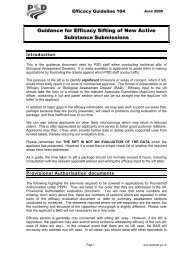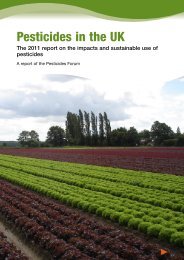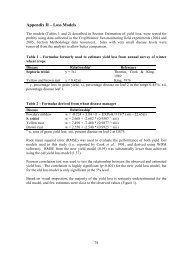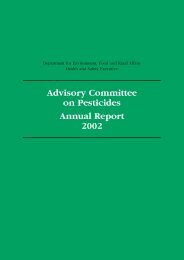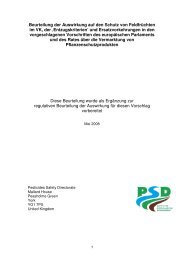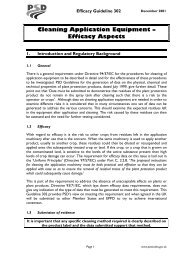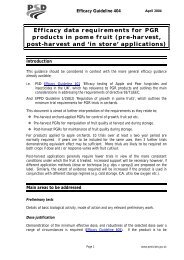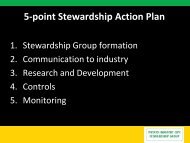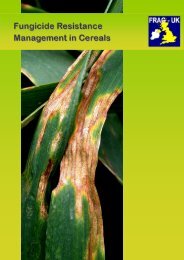Advisory Committee on Pesticides Annual Report 2001
ACP Annual Report 2001 - Pesticides Safety Directorate
ACP Annual Report 2001 - Pesticides Safety Directorate
You also want an ePaper? Increase the reach of your titles
YUMPU automatically turns print PDFs into web optimized ePapers that Google loves.
<str<strong>on</strong>g>Advisory</str<strong>on</strong>g> <str<strong>on</strong>g>Committee</str<strong>on</strong>g> <strong>on</strong> <strong>Pesticides</strong> <strong>Annual</strong> <strong>Report</strong> <strong>2001</strong><br />
Secti<strong>on</strong> F:<br />
Other items c<strong>on</strong>sidered during the year<br />
The <str<strong>on</strong>g>Committee</str<strong>on</strong>g> c<strong>on</strong>sidered the following additi<strong>on</strong>al items during <strong>2001</strong>:<br />
Pesticide usage<br />
survey reports<br />
<strong>Report</strong> 162 – Rodenticide use <strong>on</strong> farms in Great Britain growing<br />
arable crops 1998<br />
This report presented results of the fourth fully co-ordinated survey of<br />
rodenticide usage throughout Great Britain <strong>on</strong> farms growing arable crops,<br />
previous surveys having been c<strong>on</strong>ducted in 1992, 1994 and 1996.<br />
64<br />
A survey of rodenticide usage <strong>on</strong> 997 holdings growing arable crops in Great<br />
Britain in 1998 provided data which had been extrapolated to give an estimate<br />
of nati<strong>on</strong>al usage <strong>on</strong> such holdings. The most extensively used rodenticides,<br />
in terms of number of occurrences, were difenacoum, bromadiol<strong>on</strong>e,<br />
chlorophacin<strong>on</strong>e, coumatetralyl, brodifacoum and cholecalciferol/difenacoum.<br />
These six active substances accounted for 95 percent of all occurrences<br />
excluding holdings where the product was unknown, and the report<br />
c<strong>on</strong>centrates <strong>on</strong> the comparis<strong>on</strong> of usage between these six principal<br />
rodenticides. All other rodenticides had <strong>on</strong>ly limited occurrence and<br />
informati<strong>on</strong> c<strong>on</strong>cerning their usage requires cautious interpretati<strong>on</strong> as the<br />
data may have been subject to statistical error.<br />
Eastern regi<strong>on</strong> accounted for 37 percent, by weight, of the total amount of the<br />
principal active substances used in Great Britain, with Scotland and Northern<br />
regi<strong>on</strong> accounting for a further 15 percent and 20 percent respectively. The<br />
majority of the principal rodenticides were applied in autumn and winter<br />
(33 percent each). Rodenticides applied around buildings accounted for<br />
63 percent of the total weight of bait applied. By weight, 39 percent of the<br />
principal active substances were purchased as ready-to-use baits and farmers<br />
applied 82 percent of the total weight of the principal active substances used.<br />
The number of farms using rodenticides has risen since 1996, with<br />
86 percent of all farms using <strong>on</strong>e or more rodenticides during the year.<br />
The corresp<strong>on</strong>ding figures had been 78 percent in 1996, 79 percent in<br />
1994 and 74 percent in 1992.<br />
The percentage of rodenticides applied around buildings had increased from<br />
37 percent in 1996 to 59 percent of the total weight of bait applied in 1998<br />
with a corresp<strong>on</strong>ding reducti<strong>on</strong> in the use of rodenticides inside buildings




